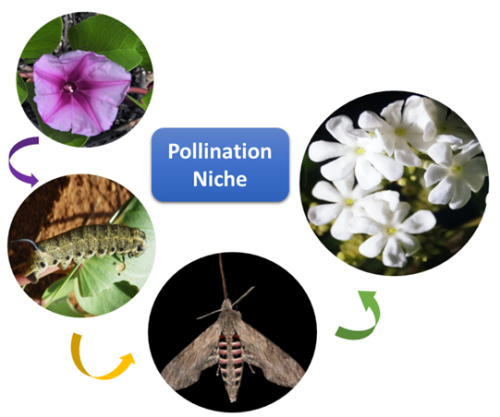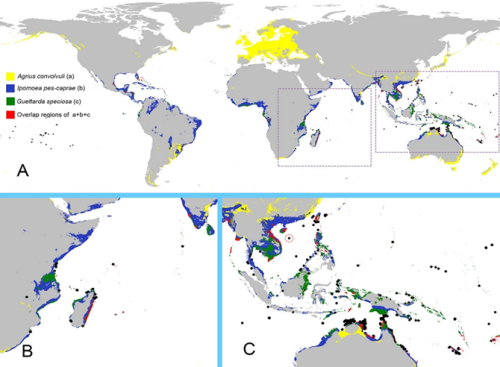Generally, a large part of plant species that colonized on oceanic islands is self-compatible. According to Baker’s rule, due to mate limitation, self-compatible species are more advantageous during colonizing new habitat following long distance dispersal than self-incompatible species. That means self-incompatible plants have difficulty in sexual reproduction because they need more than one individual to mate. A census indicates that only 18% of plants on islands are self-incompatible far below the 50% in mainland. Obviously, self-fertilized species are supposed to be better colonizers on islands.
In contrast to the prediction of Baker’s rule, our study indicates that the G. speciosa features heteromorphic self-incompatibility and strong dispersal ability on islands. Heteromorphic self-incompatibility is a common feature in heterostylous plants. The population of heterostylous species is comprised of two or three floral morphs that differ in style height. Heteromorphic self-incompatibility means that the pollen grains from self and another individual of the same morph can’t fertilize the ovules. Obviously, it is an obligate out-crossing system. In fact, heterostyly is rarely reported in island plants. It’s more difficult for heterostylous plants especially with self-incompatibility to colonize islands because they need not only more than one individual but also more than one morph. Furthermore, the balance between different morphs in population requires out-crossing to sustain, otherwise the population will deviate from equilibrium morph ratio as a result of the breakdown of heteromorphic self-incompatibility. On Xisha Islands, the population of G. speciosa is comprised of short and long style morph, and the ratio is in equilibrium. What’s more, it’s completely heteromorphic self-incompatible. Therefore, the population was built through sexual reproduction. As such an obligate out-crossing plant, G. speciosa spreads widely in tropical and subtropical islands and colonizes as a dominant species, while its two self-fertile sister species are narrowly distributed. Its success seems to have overcome the disadvantage of out-crossing, showing contrast to the Baker’s rule. What kind of enchantment support the G. speciosa to get dominant status?
We settled this question by pollination niche theory. The pollination resource take use by a plant is its pollination niche. Self-pollinated plants get pollination niche from themselves, and wind pollinated plants get pollination niche from wind, and animal pollinated plants get from pollinator. For animal pollinated plants, mate limitation actually is conducted by pollination. For instance, the paucity of pollinator strongly limits pollen flow in population resulting in mate limitation. Obviously, for such a self-incompatible plant like G. speciosa, pollination niche availability is an essential condition to establish in new habitats through sexual reproduction.
How to prove this hypothesis? Similarly to the other basic ecological niches, pollination niche sustains the plants, and in turn restricts the plants’ distribution, which means the geographic distribution of the plants will be interfered by the pollinators likewise climate. If pollination niche availability is essential for the acclimatization of G. speciosa on islands, the distribution range of G. speciosa will be contained in the pollinators’ distribution (nested models) which means they share similar ecological niche. Its occurrence will concentrate in pollinator-available regions due to its dependence on pollinator. On our study sites, Agrius convolvuli is the only effective pollinator. This moth parasitic on Ipomoea pes-caprae which is a pioneer plant often co-existing with G. speciosa in coral islands but distributed more widely.

Fig.1 From left:I. pes-caprae, larvae of A. convolvuli, adult of the moth, G. speciosa; the I. pes-caprae rise the moth, and the moth pollinate G. speciosa.
We applied Ecological Niche Modelling to predict the distribution areas of G. speciosa, the moth and its host plant. The results show that G. speciosa, A. convolvuli and I. pes-caprae share similar niche on small oceanic islands, and the empirical occurrence incline to niche overlapping areas of three species. This suggests that G. speciosa have a distribution preference for pollination niche available areas. In other words, A. convolvuli and I. pes-caprae play a significant role in the process of dispersal and colonization of G. speciosa on islands. Therefore, this conclusion proves the pollination niche theory.

Fig.2 ENM predicted distribution regions for G. speciosa (green), A. convolvuli (yellow) and I. pes-caprae (blue). Red color highlight the overlapping areas of the three species, and black dots indicate the occurrence records of G. speciosa. Red dashed circle in figure C highlights the experimental site, Yongxing Island.
In this case, pollination niche availability seems to be a more important factor affecting on the plants distribution range rather than mating system. It provides an alternative comprehension for the natural selection on plant mating system during dispersal and expanding. Our study results wouldn’t deny that an out-breeding system will add disadvantage on the new colonizers, but whether it will hinder plants dispersal and colonization remains negotiable.
Even though our research focus only one species G. speciosa, it’s conducive to recover the ecology history of plants on islands. This research is published on Scientific Reports (https://www.nature.com/articles/s41598-018-32143-5).

